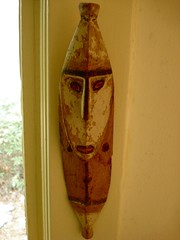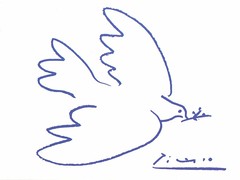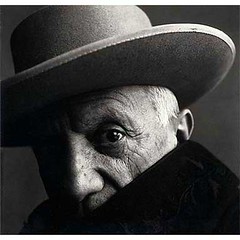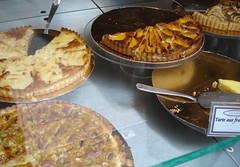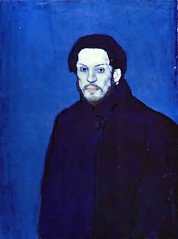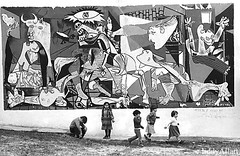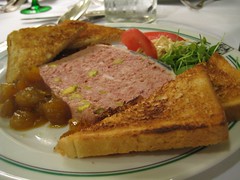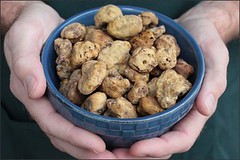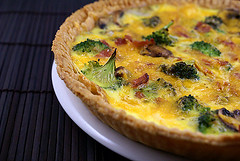Old questions from quizzes on this, the class blog, will form the basis for an 80 question test in the fine arts exam.
- Open notes.
- Multiple choice.
- Some questions will be presented verbatim and some will be tweaked.
20 pts will be given to a comparison essay. Students must assemble the research on the topics and write the notes in advance of the exam. The final draft of the essay will be written during the exam period.
Topic choices:
- Societies in which art was pervasive and expert in execution: the Egyptians and the Greeks.
- Artistic and classic style in expression / the parallels between communication through photography and through prose.
- The arts of Jazz and dance: comparing personalities and techniques in the related fields of hot music and hot movement
Wednesday, December 15, 2010
African masks influenced Picasso, Matisse and other modernists
In the early 20th century, African artifacts were being brought back to Paris museums in consequence of the expansion of the French empire into Africa, says Wikipedia.
The press was abuzz with exaggerated stories of cannibalism and exotic tales about the African kingdom of Dahomey. The mistreatment of Africans in the Belgian Congo was exposed in Joseph Conrad's popular book, Heart of Darkness.
It was natural in this climate of African interest that Picasso would look towards African artifacts as inspiration for some of his work; his interest was sparked by Henri Matisse who showed him a mask from the Dan region of Africa.[2]
In May or June 1907, Picasso experienced a "revelation" while viewing African art at the ethnographic museum at Palais du Trocadéro.[3] Picasso's discovery of African art influenced the style of his painting Les Demoiselles d'Avignon (begun in May 1907 and reworked in July of that year), especially in the treatment of the two figures on the right side of the composition.
Although Les Demoiselles is seen as the first Cubist work, Picasso continued to develop a style derived from African art before beginning the Analytic Cubism phase of his painting in 1910.
Other works of Picasso's African Period include the Bust of a Woman (1907, in the National Gallery, Prague); Mother and Child (Summer 1907, in the Musée Picasso, Paris); Nude with Raised Arms (1907, in the Thyssen-Bornemisza Museum, Lugano, Switzerland); and Three Woman (Summer 1908, in the Hermitage Museum, St. Petersburg).
The press was abuzz with exaggerated stories of cannibalism and exotic tales about the African kingdom of Dahomey. The mistreatment of Africans in the Belgian Congo was exposed in Joseph Conrad's popular book, Heart of Darkness.
It was natural in this climate of African interest that Picasso would look towards African artifacts as inspiration for some of his work; his interest was sparked by Henri Matisse who showed him a mask from the Dan region of Africa.[2]
In May or June 1907, Picasso experienced a "revelation" while viewing African art at the ethnographic museum at Palais du Trocadéro.[3] Picasso's discovery of African art influenced the style of his painting Les Demoiselles d'Avignon (begun in May 1907 and reworked in July of that year), especially in the treatment of the two figures on the right side of the composition.
Although Les Demoiselles is seen as the first Cubist work, Picasso continued to develop a style derived from African art before beginning the Analytic Cubism phase of his painting in 1910.
Other works of Picasso's African Period include the Bust of a Woman (1907, in the National Gallery, Prague); Mother and Child (Summer 1907, in the Musée Picasso, Paris); Nude with Raised Arms (1907, in the Thyssen-Bornemisza Museum, Lugano, Switzerland); and Three Woman (Summer 1908, in the Hermitage Museum, St. Petersburg).
Tuesday, December 14, 2010
Essay comparing Picasso & Steve Jobs
In-class comparison essay on Th:
compare the technology-changing Steve Jobs to the art-changing Pablo Picasso. Bring your notes on Picasso. I will supply the note on Jobs and Apple.
The dove of peace and Picasso:
Picasso's last daughter is named Paloma. That means "dove," an animal which was an important image for the artist. "Picasso donated the dove of peace sketch to the Soviet backed World Peace Congress of 1949. It was rather sad that the Stalinist ideology of Communism betrayed the aspirations of peace loving Socialists like Picasso," says biographyonline.com.
Says Wikipedia:
"Picasso's lithograph, La Colombe (The Dove), a traditional, realistic picture of a pigeon, was chosen as the emblem for the World Peace Congress in Paris in April 1949. The dove became a symbol for the peace movement and the ideals of the Communist Party and was used in Communist demonstrations of the period. At the 1950 World Peace Congress in Sheffield, Picasso said that his father had taught him to paint doves, concluding, "I stand for life against death; I stand for peace against war."[13][14]"
As Fine Arts Survey knows from the John Richardson bio, Picasso learned from his dad how to draw pigeons.
Close enough, right?
compare the technology-changing Steve Jobs to the art-changing Pablo Picasso. Bring your notes on Picasso. I will supply the note on Jobs and Apple.
The dove of peace and Picasso:
Picasso's last daughter is named Paloma. That means "dove," an animal which was an important image for the artist. "Picasso donated the dove of peace sketch to the Soviet backed World Peace Congress of 1949. It was rather sad that the Stalinist ideology of Communism betrayed the aspirations of peace loving Socialists like Picasso," says biographyonline.com.
Says Wikipedia:
"Picasso's lithograph, La Colombe (The Dove), a traditional, realistic picture of a pigeon, was chosen as the emblem for the World Peace Congress in Paris in April 1949. The dove became a symbol for the peace movement and the ideals of the Communist Party and was used in Communist demonstrations of the period. At the 1950 World Peace Congress in Sheffield, Picasso said that his father had taught him to paint doves, concluding, "I stand for life against death; I stand for peace against war."[13][14]"
As Fine Arts Survey knows from the John Richardson bio, Picasso learned from his dad how to draw pigeons.
Close enough, right?
Picasso, Pablo (1881-1973) - 1907 Les Demoiselles d' Avignon (Museum of Modern Art, New York City)

Picasso, Pablo (1881-1973) - 1907 Les Demoiselles d' Avignon (Museum of Modern Art, New York City)
Originally uploaded by RasMarley
among his most famous works are the proto-Cubist Les Demoiselles d'Avignon (1907) and Guernica (1937), his portrayal of the German bombing of Guernica during the Spanish Civil War.
This 1907 masterpiece by Picasso is the first great piece of cubist art. The influence of African masks is obvious, especially in the two figures on the right.
Notes from Wikipedia -
- Picasso was married twice and had four children by three women. He had a never-ending series of lovers - ex. Dora Maar - in addition to wives and principal mistresses.
-He was publicly a Communist - from the late 1940's. Yet one would argue that he was apolitical: he remained neutral during World War I, the Spanish Civil War, and World War II, refusing to fight for any side or country.
- During the Second World War, Picasso remained in Paris while the Germans occupied the city.
- After the war he became famous and wealthy (ex: the 1946 retrospective show at MoMa). He moved permanently to Provence, near the Med. The last 12 years he lived in the small town of Mougins, near the famous beach resort of Cannes.
- The climate is Mediterranean and the city enjoys 12 hours of sunshine per day during summer (May to September), while in winter (December to February) the weather is mild. Both seasons see a relatively low rainfall and most rain is during October and November, when 110 mm falls.
- Mougins has been frequented and inhabited by many artists and celebrities, including Pablo Picasso, Jean Cocteau, Fernand Léger, Francis Picabia, Man Ray, Yves Klein, Yves Saint Laurent, Christian Dior, Winston Churchill, Catherine Deneuve, Édith Piaf.
- The region of Mougins - Provence - has been home to artists such as Henri Matisse,Vincent Van Gogh, Paul Cezanne, Auguste Renoir, Pierre Bonnard and Claude Monet.
Misogyny and machismo - hatred of women and exaggerated sense of maleness, were both part of the Spanish nature of Picasso.
Monday, December 13, 2010
Pablo Picasso,1957
A review of the PIcasso bio -
1. Like Lennon & McCartney, Pablo Picasso was competitive with his peers. He both worked with and in an effort to top fellows like:
a) Jackson Pollock b) Henri Matise c) Chuck Close d) Richard Serra.
2. Picasso would have served you a supper of a) tortellini b) sauerkraut c) mughal curry d) paella.
3. The Spanish peninsula was occupied by the Romans and, later, by the North African Moors. The peninsula is called a) Apulia b) Iberia
c) Anatolia d) Barcelona.
4. Seville, Cordova, Granada: these are the Moorish cities of Spain's southern region. It is known as a) Andalusia b) Navarre c) Valencia d) Aragon.
5. The region of Paris historically notable for pimps, eccentrics, anarchists, students and artists: a) Bastille b) le Louvre c) Montmartre d) Champs Elysees.
6. In stage production the Harlequin is the hungry, lecherous and acrobatic
a) buffoon b) protagonist c) antagonist d) heroine.
7. Which order of production is correct? a) opium>morphine>heroin b) heroin>opium>morphine c) morphine>opium>heroin.
8. Les Demoiselles d'Avignon were a group of young women in a brothel in a) Madrid b) Paris c) Barcelona d) Malaga.
9. We can see that Picasso saw himself as a shaman, an intermediary between the human and spirit worlds, by his display of influence from a) surrealism b) cubism c) Africa d) mythology.
10. Chinese influence in Paris: a) Lapin Agile b) Les Deux Magots c) Harlequins d) opium.
11. This figure dwelled at the heart of the Cretan labyrinth: a) Harlequin b) minotaur c) Alhambra d) Odysseus.
12. The Spanish Civil War featured a Fascist force versus an anti-government rebel force. T / F
13. Gynophobia: a) fear of exercise b) fear of witches c) fear of female physicians d) fear of women.
14. Exaggerated male attitude: a) machismo b) pacifism c) misogyny d) fascism.
15. Religious Society of Friends (Quakers), Amish, Mennonites:
a) machismo b) pacifism c) misogyny d) fascism.
16. Mapping the life of Picasso: 1. Malaga 2. Barcelona 3. ___ 4. Paris 17. Provence region and Cote d'Azur of France.
a) London b) Valencia c) Marseille d) Seville.
18. In Paris, one of Picasso's most frequent destinations was the
a) Louvre b) Tour Eiffel c) Notre Dame de Paris d) River Seine
1. Like Lennon & McCartney, Pablo Picasso was competitive with his peers. He both worked with and in an effort to top fellows like:
a) Jackson Pollock b) Henri Matise c) Chuck Close d) Richard Serra.
2. Picasso would have served you a supper of a) tortellini b) sauerkraut c) mughal curry d) paella.
3. The Spanish peninsula was occupied by the Romans and, later, by the North African Moors. The peninsula is called a) Apulia b) Iberia
c) Anatolia d) Barcelona.
4. Seville, Cordova, Granada: these are the Moorish cities of Spain's southern region. It is known as a) Andalusia b) Navarre c) Valencia d) Aragon.
5. The region of Paris historically notable for pimps, eccentrics, anarchists, students and artists: a) Bastille b) le Louvre c) Montmartre d) Champs Elysees.
6. In stage production the Harlequin is the hungry, lecherous and acrobatic
a) buffoon b) protagonist c) antagonist d) heroine.
7. Which order of production is correct? a) opium>morphine>heroin b) heroin>opium>morphine c) morphine>opium>heroin.
8. Les Demoiselles d'Avignon were a group of young women in a brothel in a) Madrid b) Paris c) Barcelona d) Malaga.
9. We can see that Picasso saw himself as a shaman, an intermediary between the human and spirit worlds, by his display of influence from a) surrealism b) cubism c) Africa d) mythology.
10. Chinese influence in Paris: a) Lapin Agile b) Les Deux Magots c) Harlequins d) opium.
11. This figure dwelled at the heart of the Cretan labyrinth: a) Harlequin b) minotaur c) Alhambra d) Odysseus.
12. The Spanish Civil War featured a Fascist force versus an anti-government rebel force. T / F
13. Gynophobia: a) fear of exercise b) fear of witches c) fear of female physicians d) fear of women.
14. Exaggerated male attitude: a) machismo b) pacifism c) misogyny d) fascism.
15. Religious Society of Friends (Quakers), Amish, Mennonites:
a) machismo b) pacifism c) misogyny d) fascism.
16. Mapping the life of Picasso: 1. Malaga 2. Barcelona 3. ___ 4. Paris 17. Provence region and Cote d'Azur of France.
a) London b) Valencia c) Marseille d) Seville.
18. In Paris, one of Picasso's most frequent destinations was the
a) Louvre b) Tour Eiffel c) Notre Dame de Paris d) River Seine
Thursday, December 9, 2010
La cuisine: the vocab of French cooking
The Fine Art of French cooking
vocab -
* Escargots Burguignon: snails served in a garlic-butter sauce.
* fromage: cheese
* brie: a type of goat cheese
* mayonnaise: sauce of olive oil, eggs, lemon, etc.
* pomme de terre frites: french fries (aka "frites")
* ecrevisses: crawfish
* boudin noir: rice-filled pork sausage - with congealed blood.
* pate de foie gras: liver paste; made of fattened goose livers.
* truffles: underground fungal plant & snob appeal food
* boeuf Burguignon: beef stew with wine
* petit dejeuner : breakfast
* dejeuner: lunch (typically, 2 hours)
* le diner: supper (2 hrs later than American supper).
* pain perdu: French toast.
* le pain: bread. a baguette is a long, thin loaf of French bread.
* quiche Lorraine: egg-cheese pie.
* Perrier: bottled, sparkling water from France.
* Bon appetit! "Good eating!"
* un apéritif - cocktail, pre-dinner drink
* le café - coffee
* un œuf, des œufs egg, eggs
* le sel salt
* le sucre sugar
* a la carte - from the menu; more expensive than ordering le prix fixe (the supper recommended by the restaurant).
* oenophile - wine connoiseur
* champagne - sparkling wine, which is twice-fermented, from the region of Champagne.
- liqueur - fortified, often fruit-flavored wines (about 40% alcohol as opposed to the 15 - 18 % of an ordinary Bordeaux), such as Amaretto (almond flavored), Grand Marnier (orange-flavored), Ouzo (licorice-flavored) and Creme de Menthe (mint-flavored).
- brandy - a strong, distilled wine; example: cognac from the Perigord region of France.
vocab -
* Escargots Burguignon: snails served in a garlic-butter sauce.
* fromage: cheese
* brie: a type of goat cheese
* mayonnaise: sauce of olive oil, eggs, lemon, etc.
* pomme de terre frites: french fries (aka "frites")
* ecrevisses: crawfish
* boudin noir: rice-filled pork sausage - with congealed blood.
* pate de foie gras: liver paste; made of fattened goose livers.
* truffles: underground fungal plant & snob appeal food
* boeuf Burguignon: beef stew with wine
* petit dejeuner : breakfast
* dejeuner: lunch (typically, 2 hours)
* le diner: supper (2 hrs later than American supper).
* pain perdu: French toast.
* le pain: bread. a baguette is a long, thin loaf of French bread.
* quiche Lorraine: egg-cheese pie.
* Perrier: bottled, sparkling water from France.
* Bon appetit! "Good eating!"
* un apéritif - cocktail, pre-dinner drink
* le café - coffee
* un œuf, des œufs egg, eggs
* le sel salt
* le sucre sugar
* a la carte - from the menu; more expensive than ordering le prix fixe (the supper recommended by the restaurant).
* oenophile - wine connoiseur
* champagne - sparkling wine, which is twice-fermented, from the region of Champagne.
- liqueur - fortified, often fruit-flavored wines (about 40% alcohol as opposed to the 15 - 18 % of an ordinary Bordeaux), such as Amaretto (almond flavored), Grand Marnier (orange-flavored), Ouzo (licorice-flavored) and Creme de Menthe (mint-flavored).
- brandy - a strong, distilled wine; example: cognac from the Perigord region of France.
Tuesday, December 7, 2010
Picasso, Pablo (1881-1973) - 1901 Self Portrait in Blue Period, Paris
Pablo Diego José Francisco de Paula Juan Nepomuceno María de los Remedios Cipriano de la Santísima Trinidad Ruiz y Picasso,
known as Pablo Ruiz Picasso,
was a Spanish painter, draughtsman, and sculptor who lived most of his adult life in France. He is best known for co-founding the Cubist movement and for the wide variety of styles embodied in his work.
Fine Arts students will learn about his life largely from a video production called "Picasso: Magic, Sex, Death, The Secrets behind the Paint."
vocab -
Malaga
Andalusia
La Coruna
Barcelona
Madrid
Paris
Provence
Cote d'Azur
Riviera
Don Jose Picasso
pigeons
classic style
realism
gypsies
Catholic / atheist
garrett
anarchists
decadents
opium
suicide
impotent
Lapin Agile
Blue Period
1881 - 1973 - 91 years
known as Pablo Ruiz Picasso,
was a Spanish painter, draughtsman, and sculptor who lived most of his adult life in France. He is best known for co-founding the Cubist movement and for the wide variety of styles embodied in his work.
Fine Arts students will learn about his life largely from a video production called "Picasso: Magic, Sex, Death, The Secrets behind the Paint."
vocab -
Malaga
Andalusia
La Coruna
Barcelona
Madrid
Paris
Provence
Cote d'Azur
Riviera
Don Jose Picasso
pigeons
classic style
realism
gypsies
Catholic / atheist
garrett
anarchists
decadents
opium
suicide
impotent
Lapin Agile
Blue Period
1881 - 1973 - 91 years
Probably Picasso's most famous work: "Guernica"
Probably Picasso's most famous work, Guernica is certainly the his most powerful political statement, painted as an immediate reaction to the Nazi's devastating casual bombing practice on the Basque town of Guernica during Spanish Civil War.
Guernica shows the tragedies of war and the suffering it inflicts upon individuals, particularly innocent civilians, says pablopicasso.org.
This work has gained a monumental status, becoming a perpetual reminder of the tragedies of war, an anti-war symbol, and an embodiment of peace.
On completion Guernica was displayed around the world in a brief tour, becoming famous and widely acclaimed. This tour helped bring the Spanish Civil War to the world's attention.
This work is seen as an amalgmation of pastoral and epic styles. The discarding of color intensifies the drama, producing a reportage quality as in a photographic record. Guernica is blue, black and white, 3.5 metre (11 ft) tall and 7.8 metre (25.6 ft) wide, a mural-size canvas painted in oil. This painting can be seen in the Museo Reina Sofía in Madrid.
Interpretations of Guernica vary widely and contradict one another. This extends, for example, to the mural's two dominant elements: the bull and the horse.
Art historian Patricia Failing said, "The bull and the horse are important characters in Spanish culture. Picasso himself certainly used these characters to play many different roles over time. This has made the task of interpreting the specific meaning of the bull and the horse very tough. Their relationship is a kind of ballet that was conceived in a variety of ways throughout Picasso's career."
Some critics warn against trusting the political message in Guernica. For instance the rampaging bull, a major motif of destruction here, has previously figured, whether as a bull or Minotaur, as Picasso's ego. However, in this instance the bull probably represents the onslaught of Fascism.
Picasso said it meant brutality and darkness, presumably reminiscent of his prophesy. He also stated that the horse represented the people of Guernica.
Guernica shows the tragedies of war and the suffering it inflicts upon individuals, particularly innocent civilians, says pablopicasso.org.
This work has gained a monumental status, becoming a perpetual reminder of the tragedies of war, an anti-war symbol, and an embodiment of peace.
On completion Guernica was displayed around the world in a brief tour, becoming famous and widely acclaimed. This tour helped bring the Spanish Civil War to the world's attention.
This work is seen as an amalgmation of pastoral and epic styles. The discarding of color intensifies the drama, producing a reportage quality as in a photographic record. Guernica is blue, black and white, 3.5 metre (11 ft) tall and 7.8 metre (25.6 ft) wide, a mural-size canvas painted in oil. This painting can be seen in the Museo Reina Sofía in Madrid.
Interpretations of Guernica vary widely and contradict one another. This extends, for example, to the mural's two dominant elements: the bull and the horse.
Art historian Patricia Failing said, "The bull and the horse are important characters in Spanish culture. Picasso himself certainly used these characters to play many different roles over time. This has made the task of interpreting the specific meaning of the bull and the horse very tough. Their relationship is a kind of ballet that was conceived in a variety of ways throughout Picasso's career."
Some critics warn against trusting the political message in Guernica. For instance the rampaging bull, a major motif of destruction here, has previously figured, whether as a bull or Minotaur, as Picasso's ego. However, in this instance the bull probably represents the onslaught of Fascism.
Picasso said it meant brutality and darkness, presumably reminiscent of his prophesy. He also stated that the horse represented the people of Guernica.
Priapus by Bernini Italian 1616 CE
In Greek mythology, Priapos, Latinized as Priapus, was a minor rustic fertility god, protector of livestock, fruit plants, gardens and male genitalia.
Priapus was best noted for his large, permanent erection, which gave rise to the medical term priapism.
Priapus was best noted for his large, permanent erection, which gave rise to the medical term priapism.
Expensive spicy meat paste: pate'
Pâté is a mixture of ground meat and fat minced into a spreadable paste. Common additions include vegetables, herbs, spices, and wine.
In French or Belgian cuisine, pâté may be baked in a crust as pie or loaf, in which case it is called pâté en croûte or baked in a terrine (or other mold), in which case it is known as pâté en terrine.
The most famous pâté is probably pâté de foie gras, made from the fattened livers of geese. Foie gras entier is fattened goose liver cooked and sliced, not made into pâté.
In the Netherlands, Finland, Germany, Hungary, Sweden and Austria, some liver pâtés are shaped as a soft, often spreadable sausage, called leverworst (Dutch), májpástétom/májkrém (Hungarian), or Leberwurst (German). In the United States these are sometimes called "liverwurst" (mixing English and German), or braunschweiger.
In French or Belgian cuisine, pâté may be baked in a crust as pie or loaf, in which case it is called pâté en croûte or baked in a terrine (or other mold), in which case it is known as pâté en terrine.
The most famous pâté is probably pâté de foie gras, made from the fattened livers of geese. Foie gras entier is fattened goose liver cooked and sliced, not made into pâté.
In the Netherlands, Finland, Germany, Hungary, Sweden and Austria, some liver pâtés are shaped as a soft, often spreadable sausage, called leverworst (Dutch), májpástétom/májkrém (Hungarian), or Leberwurst (German). In the United States these are sometimes called "liverwurst" (mixing English and German), or braunschweiger.
The expensive, edible fungus: the European truffle
A truffle (pronounced /ˈtrʌfəl/) is a fungi fruiting body that develops underground and are usually found in close association with trees.
The fruiting body of some truffles (mostly in the genus 'Tuber') are highly prized as a food. The 18th-century French gastronome Brillat-Savarin called these truffles "the diamond of the kitchen". Edible truffles are held in high esteem in French, Spanish, northern Italian and Greek cooking, as well as in international haute cuisine.
Growing symbiotically with oak, hazel, poplar and beech and fruiting in autumn, Italian white truffles are very highly esteemed (illustration, left). The white truffle market in Alba is busiest in the months of October and November, where a 1.6-pound white truffle sold to "The Cody" of southern California for $150,000 on November 8, 2009 during the 79th White Truffle Festival. In 2001, the Tuber magnatum truffles sold for between US$1,000 and $2,200 per pound.
The "black truffle" or "black Périgord truffle" is named after the Périgord region in France and grows exclusively with oak.
Looking for truffles in open ground is almost always carried out with specially trained pigs (truffle hogs) or, more recently, dogs.
White truffles are generally served raw, and shaved over steaming buttered pasta or salads. White or black paper-thin truffle slices may be inserted into meats, under the skins of roasted fowl, in foie gras preparations, in pâtés, or in stuffings. Some speciality cheeses contain truffles as well.
The flavour of black truffles is far less pungent and more refined than that of white truffles. It is reminiscent of fresh earth and mushrooms, and when fresh, their scent fills a room almost instantly.
In the last 30 years, new attempts for mass production of truffles have been started. Eighty percent of the truffles now produced in France come from specially planted truffle-fields.
Local farmers are opposed to a return of mass production, which would decrease the price of truffles. There are now truffle-growing areas in the United States, Spain, Sweden, New Zealand, Australia, Chile and the UK.
The fruiting body of some truffles (mostly in the genus 'Tuber') are highly prized as a food. The 18th-century French gastronome Brillat-Savarin called these truffles "the diamond of the kitchen". Edible truffles are held in high esteem in French, Spanish, northern Italian and Greek cooking, as well as in international haute cuisine.
Growing symbiotically with oak, hazel, poplar and beech and fruiting in autumn, Italian white truffles are very highly esteemed (illustration, left). The white truffle market in Alba is busiest in the months of October and November, where a 1.6-pound white truffle sold to "The Cody" of southern California for $150,000 on November 8, 2009 during the 79th White Truffle Festival. In 2001, the Tuber magnatum truffles sold for between US$1,000 and $2,200 per pound.
The "black truffle" or "black Périgord truffle" is named after the Périgord region in France and grows exclusively with oak.
Looking for truffles in open ground is almost always carried out with specially trained pigs (truffle hogs) or, more recently, dogs.
White truffles are generally served raw, and shaved over steaming buttered pasta or salads. White or black paper-thin truffle slices may be inserted into meats, under the skins of roasted fowl, in foie gras preparations, in pâtés, or in stuffings. Some speciality cheeses contain truffles as well.
The flavour of black truffles is far less pungent and more refined than that of white truffles. It is reminiscent of fresh earth and mushrooms, and when fresh, their scent fills a room almost instantly.
In the last 30 years, new attempts for mass production of truffles have been started. Eighty percent of the truffles now produced in France come from specially planted truffle-fields.
Local farmers are opposed to a return of mass production, which would decrease the price of truffles. There are now truffle-growing areas in the United States, Spain, Sweden, New Zealand, Australia, Chile and the UK.
Thursday, December 2, 2010
French fete for Fine Arts class - next Thurs
Making and sharing French food is a joy as well as part of a fine arts education. The French are obsessed with freshness and simplicity , and yet they love complexity, too.
In fact, the words "cuisine" and "restaurant" are 2 of many words in the realm of eating that we have borrowed from the French.
Whether it's the exotic Escargots Burguignon (snails in garlic-butter sauce) or the cheese pie called a quiche, the world of French eating is appealing.
For 15 pts, please plan to contribute a dish to the class French Fete (feast).
Recommended dishes are those that can easily be served cold - with little fuss.
- A quiche is super-easy to make and there are numerous quiche recipes from which to choose.
- Boudin is a sausage that actually connects French and Cajun tradition.
- Crepes are easy and can be filled with chicken and creme sauce or can become a dessert item, being filled with butter and jam. Please do not improvise but find a recipe to guide your crepe dish.
- Cafe' au alit (coffee with milk) - the French are coffee snobs; dark roast, demitasse cups.
- Fromage is cheese. Crackers topped with cheese is a French snack. try to find a French cheese such as a brie, gruyere, muenster, roquefort or other. Google French cheese.
- Points of toast covered with a French sauce such as a Hollandaise, a home-made mayonnaise or a béchamel.
- French bread is not easy to find in Shreveport-Bossier, but it can be combined with beurre blank or even Nutella to make an authentic snack.
If you desire, you may research more deeply and email me for permission to serve a dish not herein listed.
In fact, the words "cuisine" and "restaurant" are 2 of many words in the realm of eating that we have borrowed from the French.
Whether it's the exotic Escargots Burguignon (snails in garlic-butter sauce) or the cheese pie called a quiche, the world of French eating is appealing.
For 15 pts, please plan to contribute a dish to the class French Fete (feast).
Recommended dishes are those that can easily be served cold - with little fuss.
- A quiche is super-easy to make and there are numerous quiche recipes from which to choose.
- Boudin is a sausage that actually connects French and Cajun tradition.
- Crepes are easy and can be filled with chicken and creme sauce or can become a dessert item, being filled with butter and jam. Please do not improvise but find a recipe to guide your crepe dish.
- Cafe' au alit (coffee with milk) - the French are coffee snobs; dark roast, demitasse cups.
- Fromage is cheese. Crackers topped with cheese is a French snack. try to find a French cheese such as a brie, gruyere, muenster, roquefort or other. Google French cheese.
- Points of toast covered with a French sauce such as a Hollandaise, a home-made mayonnaise or a béchamel.
- French bread is not easy to find in Shreveport-Bossier, but it can be combined with beurre blank or even Nutella to make an authentic snack.
If you desire, you may research more deeply and email me for permission to serve a dish not herein listed.
Paralleling the excitement of Isadora Duncan: Vaslav Nijinsky and the Ballets Russe
Vaslav (or Vatslav) Nijinsky ( 1890 - 1950) was a Russian ballet dancer and choreographer of Polish descent.
He grew to be celebrated for his virtuosity and for the depth and intensity of his characterizations, says Wikipedia. He could perform en pointe, a rare skill among male dancers at the time (Albright, 2004) and his ability to perform seemingly gravity-defying leaps was also legendary.
A turning point for Nijinsky was his meeting Sergei Diaghilev, a celebrated and highly innovative producer of ballet and opera as well as art exhibitions, who concentrated on promoting Russian visual and musical art abroad,[2] particularly in Paris.
Diaghilev was heavily involved in directing and managing Nijinsky's career.
In 1909 Diaghilev took a company of Russian opera and ballet stars to Paris featuring Nijinsky and Anna Pavlova. The season of colorful Russian ballets and operas, works mostly new to the West, was a great success. It led Diaghilev to create his famous company the Ballets Russes. The Paris seasons of the Ballets Russes were an artistic and social sensation; setting trends in art, dance, music and fashion for the next decade.
Nijinsky took the creative reins and choreographed ballets, which slew boundaries and stirred controversy.
His ballets were L'après-midi d'un faune (The Afternoon of a Faun, based on Claude Debussy's Prélude à l'après-midi d'un faune) (1912), Jeux (1913), Till Eulenspiegel (1916). In The Rite of Spring (Le Sacre du Printemps), with music by Stravinsky) (1913), Nijinsky created choreography that exceeded the limits of traditional ballet and propriety. For the first time, his audiences were experiencing the futuristic, new direction of modern dance. The radically angular movements expressed the heart of Stravinsky's radically modern score.
Unfortunately, Nijinsky's new trends in dance caused a riotous reaction at the Théâtre de Champs-Élysées when they premiered in Paris. As the title character in L'après-midi d'un faune the final tableau (or scene), during which he mimed masturbation with the scarf of a nymph, caused a scandal; he was accused by half of Paris of obscenity,[citation needed] but defended by such artists as Auguste Rodin.
During World War I, Nijinsky was interned in Hungary. Diaghilev succeeded in getting him out for a North American tour in 1916.
It was around this time in his life that signs of his schizophrenia were becoming apparent to members of the company. He suffered a nervous breakdown in 1919, and his career effectively ended.[citation needed] He was diagnosed with schizophrenia and taken to Switzerland by his wife, where he was treated unsuccessfully.
He spent the rest of his life in and out of psychiatric hospitals and asylums. Nijinsky died in a clinic in London on April 8, 1950. His body was moved to Montmartre Cemetery, Paris.
He grew to be celebrated for his virtuosity and for the depth and intensity of his characterizations, says Wikipedia. He could perform en pointe, a rare skill among male dancers at the time (Albright, 2004) and his ability to perform seemingly gravity-defying leaps was also legendary.
A turning point for Nijinsky was his meeting Sergei Diaghilev, a celebrated and highly innovative producer of ballet and opera as well as art exhibitions, who concentrated on promoting Russian visual and musical art abroad,[2] particularly in Paris.
Diaghilev was heavily involved in directing and managing Nijinsky's career.
In 1909 Diaghilev took a company of Russian opera and ballet stars to Paris featuring Nijinsky and Anna Pavlova. The season of colorful Russian ballets and operas, works mostly new to the West, was a great success. It led Diaghilev to create his famous company the Ballets Russes. The Paris seasons of the Ballets Russes were an artistic and social sensation; setting trends in art, dance, music and fashion for the next decade.
Nijinsky took the creative reins and choreographed ballets, which slew boundaries and stirred controversy.
His ballets were L'après-midi d'un faune (The Afternoon of a Faun, based on Claude Debussy's Prélude à l'après-midi d'un faune) (1912), Jeux (1913), Till Eulenspiegel (1916). In The Rite of Spring (Le Sacre du Printemps), with music by Stravinsky) (1913), Nijinsky created choreography that exceeded the limits of traditional ballet and propriety. For the first time, his audiences were experiencing the futuristic, new direction of modern dance. The radically angular movements expressed the heart of Stravinsky's radically modern score.
Unfortunately, Nijinsky's new trends in dance caused a riotous reaction at the Théâtre de Champs-Élysées when they premiered in Paris. As the title character in L'après-midi d'un faune the final tableau (or scene), during which he mimed masturbation with the scarf of a nymph, caused a scandal; he was accused by half of Paris of obscenity,[citation needed] but defended by such artists as Auguste Rodin.
During World War I, Nijinsky was interned in Hungary. Diaghilev succeeded in getting him out for a North American tour in 1916.
It was around this time in his life that signs of his schizophrenia were becoming apparent to members of the company. He suffered a nervous breakdown in 1919, and his career effectively ended.[citation needed] He was diagnosed with schizophrenia and taken to Switzerland by his wife, where he was treated unsuccessfully.
He spent the rest of his life in and out of psychiatric hospitals and asylums. Nijinsky died in a clinic in London on April 8, 1950. His body was moved to Montmartre Cemetery, Paris.
Isadora Duncan, revolutionary dancer and early liberator of Western women
Isadora Duncan (May 26, 1877 - September 14, 1927) was a dancer, considered by many to be the creator of modern dance. Born in the United States, she lived in Europe and the Soviet Union from the age of 22 until her death at age 50. In the United States she was popular only in New York, and then only later in her life[citation needed]. She performed to acclaim throughout Europe, claims Wikipedia.
In her dance school in Paris she rejected traditional ballet steps to stress improvisation, emotion and the human form. Duncan believed that classical ballet, with its strict rules of posture and formation, was "ugly and against nature"; she gained a wide following.
Duncan became so famous that she inspired artists and authors to create sculpture, jewelry, poetry, novels, photographs, watercolors, prints and paintings of her. When the Théâtre des Champs-Élysées was built in 1913, her likeness was carved in its bas-relief over the entrance.
In 1922 she acted on her sympathy for the social and political revolution in the new Soviet Union and moved to Moscow. She cut a striking figure in the increasingly austere post-revolution capital, and her international prominence brought welcome attention to the new regime's artistic and cultural ferment. The Russian government's failure to follow through on extravagant promises of support for Duncan's work, combined with the country's spartan living conditions, sent her back to the West in 1924.
Throughout her career Duncan did not like the commercial aspects of public performance, regarding touring, contracts and other practicalities as distractions from her real mission: the creation of beauty and the education of the young. A gifted, if unconventional pedagogue, she was the founder of three schools dedicated to teaching her dance philosophy to groups of young girls (a brief effort to include boys was unsuccessful).
Both in her professional and private lives, Duncan flouted traditional mores and morality. She was though to be bisexual. She alluded to her Communism during her last United States tour, in 1922-23; Duncan waved a red scarf and bared her breast on stage in Boston, proclaiming, "This is red! So am I!".
Duncan bore two children, both out of wedlock.
Duncan's fondness for flowing scarves was the cause of her death in a freak automobile accident in Nice, France, on the night of September 14, 1927, at the age of 50. The scarf was hand-painted silk from the Russian-born artist Roman Chatov.
Duncan's insistence on more natural movement than that performed in ballet, along with the use of unrestricted costumes and utilization of emotional expression were highly influential on other dancers. While her schools in Europe did not survive for long, her work had impact in the art and her style is still danced by a new generation of loyal followers.
In her dance school in Paris she rejected traditional ballet steps to stress improvisation, emotion and the human form. Duncan believed that classical ballet, with its strict rules of posture and formation, was "ugly and against nature"; she gained a wide following.
Duncan became so famous that she inspired artists and authors to create sculpture, jewelry, poetry, novels, photographs, watercolors, prints and paintings of her. When the Théâtre des Champs-Élysées was built in 1913, her likeness was carved in its bas-relief over the entrance.
In 1922 she acted on her sympathy for the social and political revolution in the new Soviet Union and moved to Moscow. She cut a striking figure in the increasingly austere post-revolution capital, and her international prominence brought welcome attention to the new regime's artistic and cultural ferment. The Russian government's failure to follow through on extravagant promises of support for Duncan's work, combined with the country's spartan living conditions, sent her back to the West in 1924.
Throughout her career Duncan did not like the commercial aspects of public performance, regarding touring, contracts and other practicalities as distractions from her real mission: the creation of beauty and the education of the young. A gifted, if unconventional pedagogue, she was the founder of three schools dedicated to teaching her dance philosophy to groups of young girls (a brief effort to include boys was unsuccessful).
Both in her professional and private lives, Duncan flouted traditional mores and morality. She was though to be bisexual. She alluded to her Communism during her last United States tour, in 1922-23; Duncan waved a red scarf and bared her breast on stage in Boston, proclaiming, "This is red! So am I!".
Duncan bore two children, both out of wedlock.
Duncan's fondness for flowing scarves was the cause of her death in a freak automobile accident in Nice, France, on the night of September 14, 1927, at the age of 50. The scarf was hand-painted silk from the Russian-born artist Roman Chatov.
Duncan's insistence on more natural movement than that performed in ballet, along with the use of unrestricted costumes and utilization of emotional expression were highly influential on other dancers. While her schools in Europe did not survive for long, her work had impact in the art and her style is still danced by a new generation of loyal followers.
Wednesday, December 1, 2010
Nazi depredations: modern art was decadent and jazz was "degenerate music"
Degenerate art is the English translation of the German entartete Kunst, a term adopted by the Nazi regime in Germany to describe virtually all modern art, says Wikipedia.
Such art was banned on the grounds that it was un-German or Jewish Bolshevist in nature, and those identified as degenerate artists were subjected to sanctions. These included being dismissed from teaching positions, being forbidden to exhibit or to sell their art, and in some cases being forbidden to produce art entirely.
Degenerate Art was also the title of an exhibition, mounted by the Nazis in Munich in 1937, consisting of modernist artworks chaotically hung and accompanied by text labels deriding the art. Designed to inflame public opinion against modernism, the exhibition subsequently traveled to several other cities in Germany and Austria.
While modern styles of art were prohibited, the Nazis promoted paintings and sculptures that were narrowly traditional in manner and that exalted the "blood and soil" values of racial purity, militarism, and obedience. Similarly, music was expected to be tonal and free of any jazz influences; films and plays were censored. [1]
Such art was banned on the grounds that it was un-German or Jewish Bolshevist in nature, and those identified as degenerate artists were subjected to sanctions. These included being dismissed from teaching positions, being forbidden to exhibit or to sell their art, and in some cases being forbidden to produce art entirely.
Degenerate Art was also the title of an exhibition, mounted by the Nazis in Munich in 1937, consisting of modernist artworks chaotically hung and accompanied by text labels deriding the art. Designed to inflame public opinion against modernism, the exhibition subsequently traveled to several other cities in Germany and Austria.
While modern styles of art were prohibited, the Nazis promoted paintings and sculptures that were narrowly traditional in manner and that exalted the "blood and soil" values of racial purity, militarism, and obedience. Similarly, music was expected to be tonal and free of any jazz influences; films and plays were censored. [1]
Subscribe to:
Posts (Atom)

